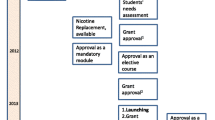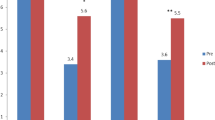Abstract
ᅟ
Similar content being viewed by others
Only 27 % of medical schools meet the National Academy of Sciences’ recommendation of 25 h of nutrition instruction for medical students [1]. Despite the efficacy of physician counseling on patient behavioral outcomes, only 19 % of graduating medical students are confident in their ability to provide nutrition education [2, 3]. The Goldring Center for Culinary Medicine at Tulane University addresses this disparity through one hour disease-centric seminars for third year students as well as a pioneering fourth year away rotation at Johnson & Wales University College of Culinary Arts. These programs build on a 24-h, eight module elective available to first and second year students. While prior piecemeal student nutrition initiatives have focused on lecture format, few studies utilize longitudinal hands-on cooking classes as well with sustained institutional support [4–6]. This contrasts with The Goldring Center providing students culinary and nutrition training over 4 years with the capstone away rotation at a culinary institute. Fourth year students there spend 53 h in culinary classes, 53 h teaching clinical care insights to culinary students, and 53 h learning nutritional counseling strategies in lifestyle modification and medication therapy for Rhode Island Hospital-associated clinics. Students transition into this opportunity from their third year seminars that unite hands-on cooking with case studies in nutritional strategies for chronic diseases. This curriculum component in the students’ final 2 years serves as the clinical translation of the classroom and community-based learning from the two preclinical years. Ongoing longitudinal analysis of school-wide surveys and national board scores are being used to assess the effectiveness of the center’s curriculum from medical school into residency and clinical practice.
References
Adams KM, Kohlmeier M, Zeisel SH (2010) Nutrition education in U.S. medical schools: latest update of a national survey. Acad Med 85(9):1537–1542
Kreuter MW, Chheda SG, Bull FC (2000) How does physician advice influence patient behavior? Evidence for a priming effect. Ann Fam Med 9(5):426–433
Spencer EH et al (2006) Predictors of nutrition counseling behaviors and attitudes in US medical students. Am J Clin Nutr 84:655–662
Reporter (US). The kitchen as a classroom: medical students get a culinary education [Internet]. Washington (DC): American Association of Medical Colleges; 2012 November. https://www.aamc.org/newsroom/reporter/november2012/314006/kitchen-classroom.html. Accessed 8 Oct 2013
Levy J, Auld G (2004) Cooking classes outperform cooking demonstrations for college sophomores. J Nutr Educ Behav 36(4):197–203
Shahril MR, Wan Dali WPE, Lua PL (2013) A 10-week multimodal nutrition education intervention improves dietary intake among university students: cluster randomised controlled trial. J Nutr Metab 2013:1–11
Author information
Authors and Affiliations
Corresponding author
Rights and permissions
About this article
Cite this article
Leong, B., Ren, D., Monlezun, D. et al. Teaching Third and Fourth Year Medical Students How to Cook: An Innovative Approach to Training Students in Lifestyle Modification for Chronic Disease Management. Med.Sci.Educ. 24, 43 (2014). https://doi.org/10.1007/s40670-014-0014-5
Published:
Issue Date:
DOI: https://doi.org/10.1007/s40670-014-0014-5




